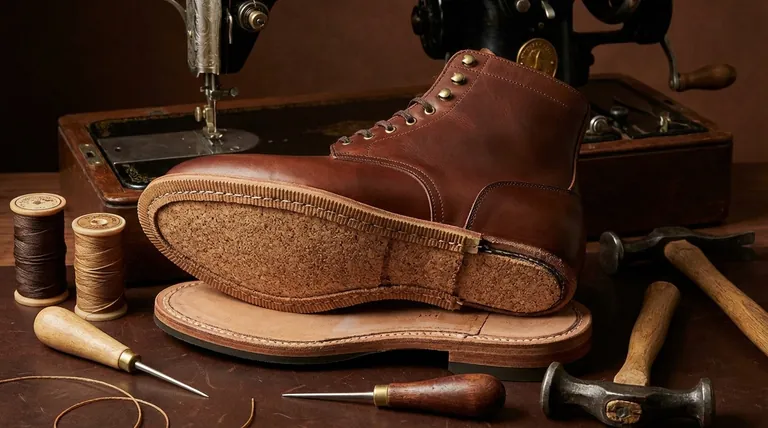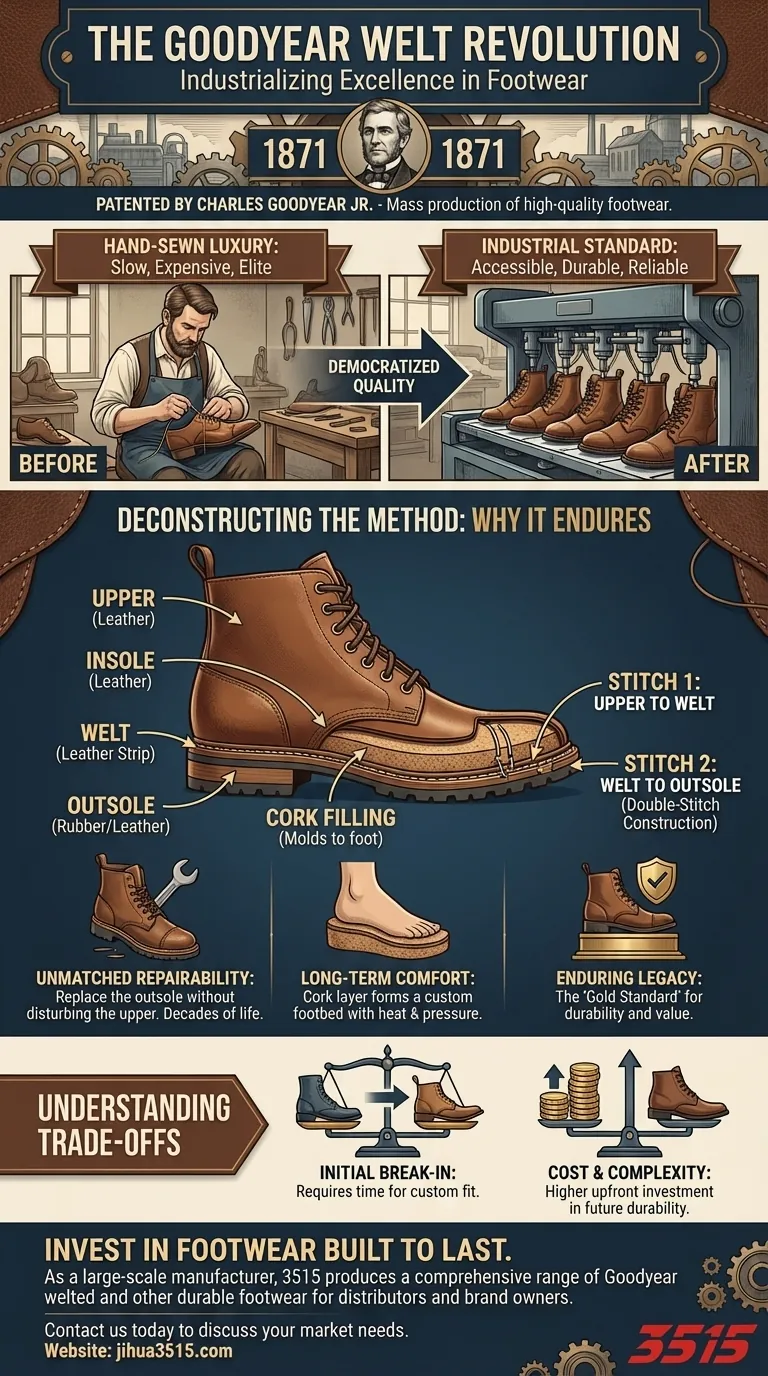Historically, the Goodyear Welt is significant because it revolutionized the footwear industry by mechanizing a superior construction method. Patented by Charles Goodyear Jr. in 1871, the process enabled the mass production of durable, water-resistant, and easily repairable shoes, making high-quality footwear accessible to a broad audience for the first time and setting a new standard for quality that endures today.
The true historical impact of the Goodyear Welt was not just the invention of a new technique, but the industrialization of excellence. It transformed long-lasting, repairable footwear from a handcrafted luxury into a widely available, reliable product.

From Hand-Sewn Luxury to an Industrial Standard
Before the late 19th century, creating durable and resoleable shoes was a slow, expensive process done entirely by hand. The Goodyear Welt machine changed everything, democratizing quality and establishing a benchmark for durable footwear that defined an era.
The Challenge Before Goodyear
For centuries, attaching a sole to a shoe's upper was a difficult craft. The most durable method, hand-welting, was incredibly time-consuming and costly, putting the longest-lasting shoes out of reach for the average person.
The Innovation of Charles Goodyear Jr.
Charles Goodyear Jr.'s invention of the Goodyear Welt sewing machine in the 1860s was a watershed moment. His machine could rapidly and consistently stitch a leather strip (the welt) to the shoe's upper and insole, creating a secure platform for attaching the outsole.
This process, patented in 1871, replaced the painstaking manual labor of hand-sewing, drastically cutting down production time and cost without sacrificing the structural integrity of the shoe.
The Impact of Mass Production
The Goodyear Welt machine allowed factories to produce high-quality, sturdy footwear on an unprecedented scale. This made exceptionally durable and repairable boots and shoes the new standard, accessible to everyone from industrial workers to soldiers and business professionals.
Deconstructing the Method: Why It Endures
The historical significance of the Goodyear Welt is directly tied to its brilliant design. Its longevity as a "gold standard" comes from a unique combination of durability, repairability, and long-term comfort that modern, cheaper methods cannot replicate.
The Welt and the Double Stitch
The core of the method is the welt, a strip of leather that runs along the perimeter of the outsole. First, the upper is stitched to the welt. Then, in a separate stitch, the welt is stitched to the outsole.
This double-stitch construction is key. It creates an incredibly secure bond and means the outsole can be removed and replaced without ever disturbing the upper. A special lockstitch is often used, which prevents the entire seam from unraveling if one part breaks.
Unmatched Repairability
The ability to easily resole a shoe is the Goodyear Welt's most celebrated feature. Because the outsole is stitched to the welt and not directly to the upper, a cobbler can slice through the outsole stitching and attach a new sole multiple times.
This dramatically extends the life of the footwear, allowing a well-cared-for pair of shoes to last for decades, not just a few seasons.
Long-Term Comfort and Support
Between the insole and the outsole, a Goodyear welted shoe contains a layer of granulated cork. While this makes the shoe feel firm at first, body heat and pressure from walking gradually cause the cork to mold to the exact shape of your foot.
This process creates a custom-like footbed, offering unparalleled support and comfort that improves the more you wear the shoe.
Understanding the Trade-offs
While the Goodyear Welt is revered, it is not the only construction method, and it comes with specific characteristics that are important to understand.
The Initial "Break-In" Period
The robust, multi-layered construction that provides such great long-term support also results in initial stiffness. Unlike a sneaker or a cemented shoe, a Goodyear welted shoe requires a break-in period as the leather and cork footbed conform to your foot.
Cost and Complexity
This method is more labor-intensive and uses more materials than modern techniques like cementing (gluing) soles on. This inherent complexity means Goodyear welted shoes are more expensive upfront, representing an investment in future durability.
Making the Right Choice for Your Goal
Understanding the history and mechanics of the Goodyear Welt helps you decide if it aligns with your needs.
- If your primary focus is longevity and long-term value: A Goodyear welted shoe is the definitive choice, as its repairability ensures it can last for decades.
- If your primary focus is traditional craftsmanship: This construction method is a hallmark of high-quality, heritage footwear from historic makers.
- If your primary focus is immediate, lightweight comfort: You may prefer a cemented or Blake-stitched shoe, but you will be sacrificing the potential for multiple resoles.
Choosing a Goodyear welted shoe is an investment in a piece of industrial history, one built on the principle of durable, sustainable quality.
Summary Table:
| Key Feature | Historical Impact |
|---|---|
| Mechanized Construction | Enabled mass production of high-quality footwear. |
| Double-Stitch Design | Created durable, water-resistant, and easily repairable shoes. |
| Democratized Quality | Made long-lasting shoes accessible beyond the wealthy elite. |
| Enduring Legacy | Set the "gold standard" for quality footwear that remains relevant today. |
Invest in footwear built to last. As a large-scale manufacturer, 3515 produces a comprehensive range of Goodyear welted and other durable footwear for distributors, brand owners, and bulk clients. Our production capabilities encompass all types of shoes and boots, ensuring your customers receive the superior quality and longevity rooted in this historic method.
Contact us today to discuss how we can bring durable, high-value footwear to your market.
Visual Guide

Related Products
- Safety Footwear Wholesale Manufacturer for Custom OEM/ODM Production
- Wholesale Durable Leather Work Boots | 8-Inch Goodyear Welt Manufacturer
- Durable Goodyear Welt Leather Work Boots for Wholesale & Private Label
- Wholesale Safety Footwear Manufacturer for Bulk & Custom OEM Orders
- Durable Leather Work Boots for Wholesale & Custom OEM Manufacturing
People Also Ask
- How do safety shoes contribute to cost savings for companies? A Strategic Investment in Risk and Cost Management
- How long can you wear safety boots? The Lifespan is Determined by Wear, Not Time
- What are the cultural perspectives on wearing shoes in the house? A Guide to Home Etiquette & Hygiene
- Is it normal to wear shoes in the house? A Guide to Hygiene, Comfort & Culture
- Do snake bite boots work? Your Ultimate Guide to Effective Snake Bite Protection



















